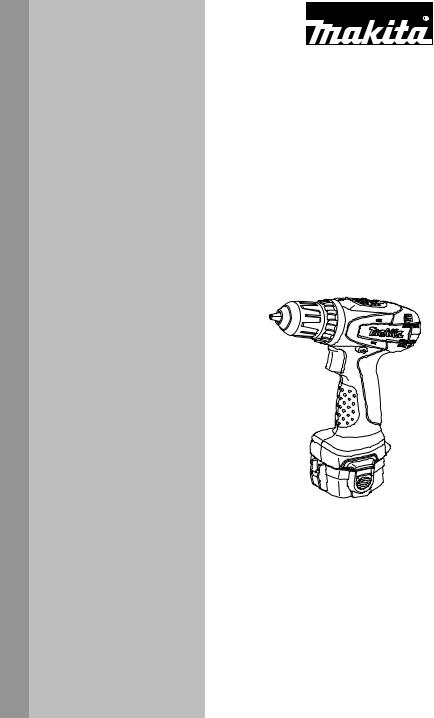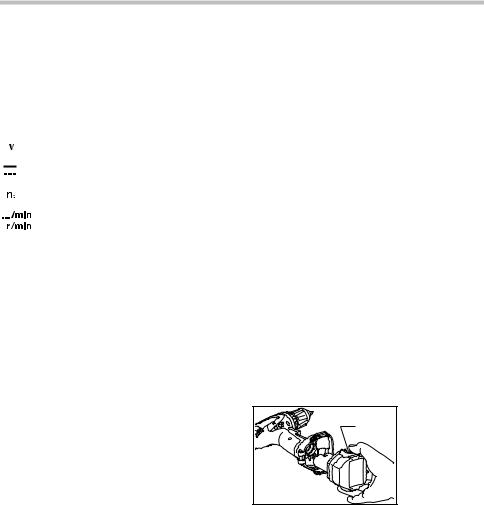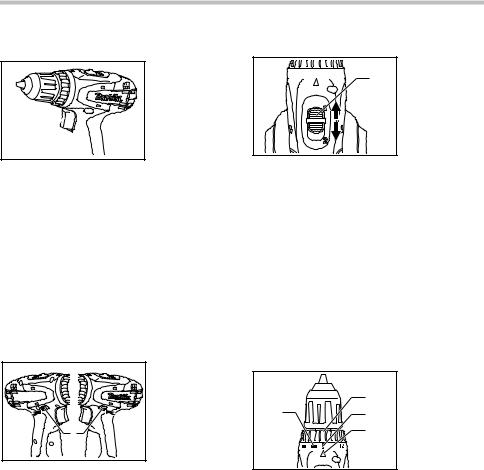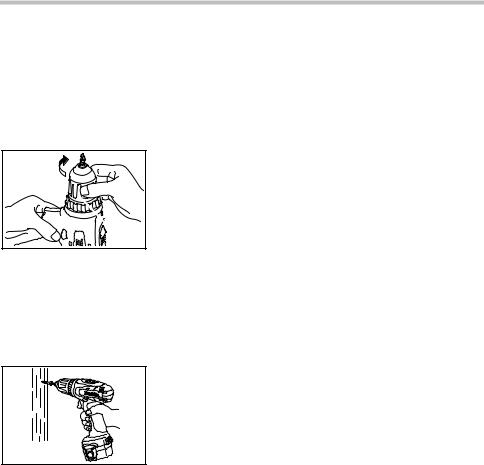Makita 6261D, 6381D, 6391D, 6281D, 6271D User Manual

INSTRUCTION MANUAL MANUEL D'INSTRUCTION
MANUAL DE INSTRUCCIONES
Cordless Driver Drill Perceuse-visseuse sans fil Atornillador-Taladro Inalámbrico
6261D
6271D
6281D
6381D
6391D
008685
 WARNING:
WARNING:
For your personal safety, READ and UNDERSTAND before using. SAVE THESE INSTRUCTIONS FOR FUTURE REFERENCE.
 AVERTISSEMENT:
AVERTISSEMENT:
Pour votre propre sécurité, prière de lire attentivement avant l'utilisation. GARDER CES INSTRUCTIONS POUR RÉFÉRENCE ULTÉRIEURE.
 ADVERTENCIA:
ADVERTENCIA:
Para su seguridad personal, LEA DETENIDAMENTE este manual antes de usar la herramienta.
GUARDE ESTAS INSTRUCCIONES PARA FUTURA REFERENCIA.

ENGLISH
SPECIFICATIONS
Model |
|
6261D |
6271D |
6281D |
6381D |
6391D |
||
|
|
Steel |
10 mm (3/8") |
10 mm (3/8") |
10 mm (3/8") |
13 mm (1/2") |
13 mm (1/2") |
|
|
|
Wood |
21 mm (13/16") |
25 mm (1") |
25 mm (1") |
25 mm (1") |
36 mm (1-7/16") |
|
Capacities |
Wood screw |
5.1 x 38 mm |
|
5.1 x 63 mm |
|
6 mm x 75 mm |
||
|
(3/16" x 1-1/2") |
|
(3/16" x 2-1/2") |
|
(1/4" x 3") |
|||
|
|
|
|
|
||||
|
|
|
|
|
|
|
||
|
Machine screw |
|
|
6 mm (1/4") |
|
|
||
No load speed (RPM) |
|
High |
|
|
0 - 1,300/min. |
|
|
|
|
Low |
|
|
0 - 400/min. |
|
|
||
|
|
|
|
|
|
|||
Overall length |
|
192 mm (7-9/16") |
192 mm (7-9/16") |
192 mm (7-9/16") |
207 mm (8-1/8") |
223 mm (8-3/4") |
||
Net weight |
|
1.4 kg ( 3.1 lbs) |
1.5 kg ( 3.3 lbs) |
1.6 kg (3.5 lbs) |
1.6 kg (3.5 lbs) |
2.2 kg (4.9 lbs) |
||
Rated voltage |
|
D.C.9.6V |
D.C.12V |
D.C.14.4V |
D.C.14.4V |
D.C.18V |
||
Standard battery cartridges |
PA09,9120, |
PA12,1220, |
PA14,1420, |
PA14,1420, |
PA18,1822, |
|||
9122,9134,9135 |
1222,1234,1235 |
1422,1434,1435 |
1422,1434,1435 |
1834,1835 |
||||
|
|
|
||||||
•Due to our continuing programme of research and development, the specifications herein are subject to change without notice.
•Note: Specifications may differ from country to country.
GEA002-3
GENERAL SAFETY RULES
WARNING! Read all instructions. Failure to follow all instructions listed below may result in electric shock, fire and/or serious injury. The term "power tool" in all of the warnings listed below refers to your mains-operated (corded) power tool or battery-operated (cordless) power tool.
SAVE THESE INSTRUCTIONS.
Work area safety
1.Keep work area clean and well lit. Cluttered and dark areas invite accidents.
2.Do not operate power tools in explosive atmospheres, such as in the presence of flammable liquids, gases or dust. Power tools create sparks which may ignite the dust or fumes.
3.Keep children and bystanders away while operating a power tool. Distractions can cause
you to lose control.
Electrical Safety
4.Power tool plugs must match the outlet. Never modify the plug in any way. Do not use any adapter plugs with earthed (grounded) power tools. Unmodified plugs and matching outlets will reduce risk of electric shock.
5.Avoid body contact with earthed or grounded surfaces such as pipes, radiators, ranges and refrigerators. There is an increased risk of electric shock if your body is earthed or grounded.
6.Do not expose power tools to rain or wet conditions. Water entering a power tool will increase the risk of electric shock.
7.Do not abuse the cord. Never use the cord for carrying, pulling or unplugging the power tool. Keep cord away from heat, oil, sharp edges or moving parts. Damaged or entangled cords increase the risk of electric shock.
8.When operating a power tool outdoors, use an extension cord suitable for outdoor use. Use of
a cord suitable for outdoor use reduces the risk of electric shock.
Personal Safety
9.Stay alert, watch what you are doing and use common sense when operating a power tool. Do not use a power tool while you are tired or under the influence of drugs, alcohol or medication. A moment of inattention while operating power tools may result in serious personal injury.
10.Use safety equipment. Always wear eye protection. Safety equipment such as dust mask, non-skid safety shoes, hard hat, or hearing protection used for appropriate conditions will reduce personal injuries.
11.Avoid accidental starting. Ensure the switch is in the off-position before plugging in. Carrying power tools with your finger on the switch or plugging in power tools that have the switch on invites accidents.
12.Remove any adjusting key or wrench before turning the power tool on. A wrench or a key left attached to a rotating part of the power tool may result in personal injury.
13.Do not overreach. Keep proper footing and balance at all times. This enables better control of the power tool in unexpected situations.
2

14.Dress properly. Do not wear loose clothing or jewellery. Keep your hair, clothing, and gloves away from moving parts. Loose clothes, jewellery or long hair can be caught in moving parts.
15.If devices are provided for the connection of dust extraction and collection facilities, ensure these are connected and properly used.
Use of these devices can reduce dust-related hazards.
Power tool use and care
16.Do not force the power tool. Use the correct power tool for your application. The correct power tool will do the job better and safer at the rate for which it was designed.
17.Do not use the power tool if the switch does not turn it on and off. Any power tool that cannot be controlled with the switch is dangerous and must be repaired.
18.Disconnect the plug from the power source and/or the battery pack from the power tool before making any adjustments, changing accessories, or storing power tools. Such preventive safety measures reduce the risk of starting the power tool accidentally.
19.Store idle power tools out of the reach of children and do not allow persons unfamiliar with the power tool or these instructions to operate the power tool. Power tools are dangerous in the hands of untrained users.
20.Maintain power tools. Check for misalignment or binding of moving parts, breakage of parts and any other condition that may affect the power tools operation. If damaged, have the power tool repaired before use. Many accidents are caused by poorly maintained power tools.
21.Keep cutting tools sharp and clean. Properly maintained cutting tools with sharp cutting edges are less likely to bind and are easier to control.
22.Use the power tool, accessories and tool bits etc. in accordance with these instructions and in the manner intended for the particular type of power tool, taking into account the working conditions and the work to be performed. Use
of the power tool for operations different from those intended could result in a hazardous situation.
Battery tool use and care
23.Ensure the switch is in the off position before inserting battery pack. Inserting the battery pack into power tools that have the switch on invites accidents.
24.Recharge only with the charger specified by the manufacturer. A charger that is suitable for one type of battery pack may create a risk of fire
when used with another battery pack.
25.Use power tools only with specifically designated battery packs. Use of any other battery packs may create a risk of injury and fire.
26.When battery pack is not in use, keep it away from other metal objects like paper clips, coins, keys, nails, screws, or other small metal objects that can make a connection from one terminal to another. Shorting the battery terminals together may cause burns or a fire.
27.Under abusive conditions, liquid may be ejected from the battery, avoid contact. If contact accidentally occurs, flush with water. If liquid contacts eyes, additionally seek medical
help. Liquid ejected from the battery may cause irritation or burns.
SERVICE
28.Have your power tool serviced by a qualified repair person using only identical replacement parts. This will ensure that the safety of the power tool is maintained.
29.Follow instruction for lubricating and changing accessories.
30.Keep handles dry, clean and free from oil and grease.
GEB002-2
SPECIFIC SAFETY RULES
DO NOT let comfort or familiarity with product (gained from repeated use) replace strict adherence to drill safety rules. If you use this power tool unsafely or incorrectly, you can suffer serious personal injury.
1.Hold power tools by insulated gripping surfaces when performing an operation where the cutting tool may contact hidden wiring or its own cord. Contact with a "live" wire will make exposed metal parts of the tool "live" and shock the operator.
2.Always be sure you have a firm footing.
Be sure no one is below when using the tool in high locations.
3.Hold the tool firmly.
4.Keep hands away from rotating parts.
5.Do not leave the tool running. Operate the tool only when hand-held.
6.Do not touch the drill bit or the workpiece immediately after operation; they may be extremely hot and could burn your skin.
7.Some material contains chemicals which may be toxic. Take caution to prevent dust inhalation and skin contact. Follow material supplier safety data.
SAVE THESE INSTRUCTIONS.
3

 WARNING:
WARNING:
MISUSE or failure to follow the safety rules stated in this instruction manual may cause serious personal injury.
USD301-1
Symbols
The followings show the symbols used for tool.
volts
direct current
no load speed
revolutions or reciprocation per minute
ENC004-1
IMPORTANT SAFETY
INSTRUCTIONS
FOR BATTERY CARTRIDGE
1.Before using battery cartridge, read all instructions and cautionary markings on (1) battery charger, (2) battery, and (3) product using battery.
2.Do not disassemble battery cartridge.
3.If operating time has become excessively shorter, stop operating immediately. It may result in a risk of overheating, possible burns and even an explosion.
4.If electrolyte gets into your eyes, rinse them out with clear water and seek medical attention right away. It may result in loss of your eyesight.
5.Always cover the battery terminals with the battery cover when the battery cartridge is not used.
6.Do not short the battery cartridge:
(1)Do not touch the terminals with any conductive material.
(2)Avoid storing battery cartridge in a container with other metal objects such as nails, coins, etc.
(3)Do not expose battery cartridge to water or rain.
A battery short can cause a large current flow, overheating, possible burns and even a breakdown.
7.Do not store the tool and battery cartridge in
locations where the temperature may reach or exceed 50 C (122 F).
8.Do not incinerate the battery cartridge even if
it is severely damaged or is completely worn out. The battery cartridge can explode in a fire.
9.Be careful not to drop or strike battery.
SAVE THESE INSTRUCTIONS.
Tips for maintaining maximum battery life
1.Charge the battery cartridge before completely discharged.
Always stop tool operation and charge the battery cartridge when you notice less tool power.
2.Never recharge a fully charged battery cartridge.
Overcharging shortens the battery service life.
3.Charge the battery cartridge with room temperature at 10 C - 40 C (50 F - 104 F).
Let a hot battery cartridge cool down before charging it.
4.Charge the Nickel Metal Hydride battery cartridge when you do not use it for more than six months.
FUNCTIONAL DESCRIPTION
 CAUTION:
CAUTION:
•Always be sure that the tool is switched off and the battery cartridge is removed before adjusting or checking function on the tool.
Installing or removing battery cartridge
1. Button
1 2. Battery
cartridge
2
008686
•Always switch off the tool before insertion or removal of the battery cartridge.
•To remove the battery cartridge, withdraw it from the tool while pressing the buttons on both sides of the cartridge.
•To insert the battery cartridge, align the tongue on the battery cartridge with the groove in the housing and slip it into place. Always insert it all the way until it locks in place with a little click. If not, it may accidentally fall out of the tool, causing injury to you or someone around you.
•Do not use force when inserting the battery cartridge. If the cartridge does not slide in easily, it is not being inserted correctly.
4

Switch action
1. Switch trigger
1


008687
 CAUTION:
CAUTION:
•Before inserting the battery cartridge into the tool,
always check to see that the switch trigger actuates properly and returns to the "OFF" position when released.
To start the tool, simply pull the switch trigger. Tool speed is increased by increasing pressure on the switch trigger. Release the switch trigger to stop.
Electric brake
This tool is equipped with an electric brake. If the tool consistently fails to quickly stop after switch trigger release, have tool serviced at a Makita service center.
Reversing switch action
1. Reversing
switch lever
A |
B |
|
1 |
008688
Speed change
|
1. |
Low speed |
|
3 |
2. |
High speed |
|
3. |
Speed change |
||
|
|||
1 |
|
lever |
|
|
|
||
2 |
|
|
008689
To change the speed, first switch off the tool and then slide the speed change lever to the "2" side for high speed or "1" side for low speed. Be sure that the speed change lever is set to the correct position before operation. Use the right speed for your job.
 CAUTION:
CAUTION:
•Always set the speed change lever fully to the correct position. If you operate the tool with the speed change lever positioned halfway between the "1" side and "2" side, the tool may be damaged.
•Do not use the speed change lever while the tool is running. The tool may be damaged.
Adjusting the fastening torque
2
1 |
3 |
4 |
1.Graduations
2.Adjusting ring
3.Drill marking
4.Pointer
008690
This tool has a reversing switch to change the direction of rotation. Depress the reversing switch lever from the A side for clockwise rotation or from the B side for counterclockwise rotation.
When the reversing switch lever is in the neutral position, the switch trigger cannot be pulled.
 CAUTION:
CAUTION:
•Always check the direction of rotation before operation.
•Use the reversing switch only after the tool comes to a complete stop. Changing the direction of rotation before the tool stops may damage the tool.
•When not operating the tool, always set the reversing switch lever to the neutral position.
5
The fastening torque can be adjusted in 17 steps by turning the adjusting ring so that its graduations are aligned with the pointer on the tool body. The fastening torque is minimum when the number 1 is aligned with the pointer, and maximum when the  marking is aligned with the pointer.
marking is aligned with the pointer.
The clutch will slip at various torque levels when set at the number 1 to 16. The clutch is designed not to slip at the  marking.
marking.
Before actual operation, drive a trial screw into your material or a piece of duplicate material to determine which torque level is required for a particular application.
NOTE:
•The adjusting ring does not lock when the pointer is positioned only halfway between the graduations.

ASSEMBLY
 CAUTION:
CAUTION:
•Always be sure that the tool is switched off and the battery cartridge is removed before carrying out any work on the tool.
Installing or removing driver bit or drill bit
1. Sleeve





 1
1
008691
Turn the sleeve counterclockwise to open the chuck jaws. Place the bit in the chuck as far as it will go. Turn the sleeve clockwise to tighten the chuck.
To remove the bit, turn the sleeve counterclockwise.
OPERATION
Screwdriving operation
008692
 CAUTION:
CAUTION:
•Adjust the adjusting ring to the proper torque level for your work.
Place the point of the driver bit in the screw head and apply pressure to the tool. Start the tool slowly and then increase the speed gradually. Release the switch trigger as soon as the clutch cuts in.
 CAUTION:
CAUTION:
•Make sure that the driver bit is inserted straight in the screw head, or the screw and/or bit may be damaged.
NOTE:
•When driving wood screws, predrill pilot holes to make driving easier and to prevent splitting of the workpiece. See the chart.
Nominal diameter of wood screw |
Recommended size of pilot hole |
(mm) |
(mm) |
|
|
3.1 (1/8") |
2.0 - 2.2 (5/64" - 3/32") |
3.5 (9/64") |
2.2 - 2.5 (3/32" - 3/32") |
3.8 (5/32") |
2.5 - 2.8 (3/32" - 7/64") |
4.5 (11/64") |
2.9 - 3.2 (7/64" - 1/8") |
4.8 (3/16") |
3.1 - 3.4 (1/8" - 9/64") |
5.1 (13/64") |
3.3 - 3.6 (1/8" - 9/64") |
5.5 (7/32") |
3.7 - 3.9 (9/64" - 5/32") |
5.8 (7/32") |
4.0 - 4.2 (5/32" - 11/64") |
6.1 (15/64") |
4.2 - 4.4 (11/64" - 11/64") |
006575
Drilling operation
First, turn the adjusting ring so that the pointer points to the  marking. Then proceed as follows.
marking. Then proceed as follows.
Drilling in wood
When drilling in wood, the best results are obtained with wood drills equipped with a guide screw. The guide screw makes drilling easier by pulling the bit into the workpiece.
Drilling in metal
To prevent the bit from slipping when starting a hole, make an indentation with a center-punch and hammer at the point to be drilled. Place the point of the bit in the indentation and start drilling.
Use a cutting lubricant when drilling metals. The exceptions are iron and brass which should be drilled dry.
 CAUTION:
CAUTION:
•Pressing excessively on the tool will not speed up the drilling. In fact, this excessive pressure will only serve to damage the tip of your bit, decrease the tool performance and shorten the service life of the tool.
•There is a tremendous force exerted on the tool/bit at the time of hole break through. Hold the tool firmly and exert care when the bit begins to break through the workpiece.
•A stuck bit can be removed simply by setting the reversing switch to reverse rotation in order to back out. However, the tool may back out abruptly if you do not hold it firmly.
•Always secure small workpieces in a vise or similar hold-down device.
•If the tool is operated continuously until the battery cartridge has discharged, allow the tool to rest for 15 minutes before proceeding with a fresh battery.
6

MAINTENANCE
 CAUTION:
CAUTION:
•Always be sure that the tool is switched off and the battery cartridge is removed before attempting to perform inspection or maintenance.
To maintain product SAFETY and RELIABILITY, repairs, any other maintenance or adjustment should be performed by Makita Authorized or Factory Service Centers, always using Makita replacement parts.
Ni-Cd
000005
Recycling the Battery
The only way to dispose of a Makita battery is to recycle it. The law prohibits any other method of disposal.
To recycle the battery:
1.Remove the battery from the tool.
2.a) Take the battery to your nearest Makita Factory Service Center
or
b)Take the battery to your nearest Makita Authorized Service Center or Distributor that has been designated as a Makita battery recycling location.
Call your nearest Makita Service Center or Distributor to determine thelocation that provides Makita battery recycling. See your local Yellow Pages under "Tools-Electric".
EN0001-1
ACCESSORIES
 CAUTION:
CAUTION:
•These accessories or attachments are recommended for use with your Makita tool specified in this manual. The use of any other accessories or attachments might present a risk of injury to persons. Only use accessory or attachment for its stated purpose.
If you need any assistance for more details regarding these accessories, ask your local Makita Service Center.
•Drill bits
•Screw bits
•Various type of Makita genuine batteries and
chargers
•Rubber pad assembly
•Wool bonnet
•Foam polishing pad
•Plastic carrying case
MAKITA LIMITED ONE YEAR WARRANTY
Warranty Policy
Every Makita tool is thoroughly inspected and tested before leaving the factory. It is warranted to be free of defects from workmanship and materials for the period of ONE YEAR from the date of original purchase. Should any trouble develop during this one year period, return the COMPLETE tool, freight prepaid, to one of Makita’s Factory or Authorized Service Centers. If inspection shows the trouble is caused by defective workmanship or material, Makita will repair (or at our option, replace) without charge.
This Warranty does not apply where:
repairs have been made or attempted by others:
repairs are required because of normal wear and tear:
the tool has been abused, misused or improperly maintained:
alterations have been made to the tool.
IN NO EVENT SHALL MAKITA BE LIABLE FOR ANY INDIRECT, INCIDENTAL OR CONSEQUENTIAL DAMAGES FROM THE SALE OR USE OF THE PRODUCT. THIS DISCLAIMER APPLIES BOTH DURING AND AFTER THE TERM OF THIS WARRANTY.
MAKITA DISCLAIMS LIABILITY FOR ANY IMPLIED WARRANTIES, INCLUDING IMPLIED WARRANTIES OF "MERCHANTABILITY" AND "FITNESS FOR A SPECIFIC PURPOSE," AFTER THE ONE YEAR TERM OF THIS WARRANTY.
This Warranty gives you specific legal rights, and you may also have other rights which vary from state to state. Some states do not allow the exclusion or limitation of incidental or consequential damages, so the above limitation or exclusion may not apply to you. Some states do not allow limitation on how long an implied warranty lasts, so the above limitation may not apply to you.
EN0006-1
7

FRANÇAIS
SPÉCIFICATIONS
|
Modèle |
6261D |
6271D |
6281D |
6381D |
6391D |
||
|
|
Acier |
10 mm (3/8") |
10 mm (3/8") |
10 mm (3/8") |
13 mm (1/2") |
13 mm (1/2") |
|
|
|
Bois |
21 mm (13/16") |
25 mm (1") |
25 mm (1") |
25 mm (1") |
36 mm (1-7/16") |
|
Capacités |
|
Vis à bois |
5.1 x 38 mm |
|
5.1 x 63 mm |
|
6 mm x 75 mm |
|
|
|
(3/16" x 1-1/2") |
|
(3/16" x 2-1/2") |
|
(1/4" x 3") |
||
|
|
|
|
|
||||
|
|
|
|
|
|
|
|
|
|
|
Vis de mécanique |
|
|
6 mm (1/4") |
|
|
|
Vitesse à vide |
|
Grande |
|
|
0 - 1,300/min |
|
|
|
(T/MIN) |
|
Bas |
|
|
0 - 400/min |
|
|
|
Longueur totale |
192 mm (7-9/16") |
192 mm (7-9/16") |
192 mm (7-9/16") |
207 mm (8-1/8") |
223 mm (8-3/4") |
|||
|
Poids net |
1.4 kg ( 3.1 lbs) |
1.5 kg ( 3.3 lbs) |
1.6 kg (3.5 lbs) |
1.6 kg (3.5 lbs) |
2.2 kg (4.9 lbs) |
||
Tension nominale |
C.C. 9.6V |
C.C. 12V |
C.C. 14.4V |
C.C. 14.4V |
C.C. 18V |
|||
Batteries standard |
PA09,9120, |
PA12,1220, |
PA14,1420, |
PA14,1420, |
PA18,1822, |
|||
9122,9134,9135 |
1222,1234,1235 |
1422,1434,1435 |
1422,1434,1435 |
1834,1835 |
||||
|
|
|
||||||
•Étant donné l'évolution constante de notre programme de recherche et de développement, les spécifications contenues dans ce manuel sont sujettes à modification sans préavis.
•Note : Les spécifications peuvent varier suivant les pays.
GEA002-3
Règles de sécurité générales
AVERTISSEMENT! Veuillez lire l'ensemble des présentes instructions. Il y a risque de choc électrique, d'incendie et/ou de blessure grave si toutes les instructions énumérées ci-dessous ne sont pas respectées. Le terme outil électrique qui figure sur tous les avertissements énumérés ci-dessous fait référence à un outil électrique branché sur une prise de courant (par un cordon d'alimentation) ou alimenté par batterie (sans fil).
CONSERVEZ CE MODE
D'EMPLOI.
Sécurité de la zone de travail
1.Maintenez la zone de travail propre et bien éclairée. Les zones de travail encombrées et sombres ouvrent grande la porte aux accidents.
2.N'utilisez pas les outils électriques dans les atmosphères explosives, par exemple en présence de liquides, gaz ou poussières inflammables. Les outils électriques produisent des étincelles au contact desquelles la poussière ou les vapeurs peuvent s'enflammer.
3.Assurez-vous qu'aucun enfant ou curieux ne
s'approche pendant que vous utilisez un outil électrique. Vous risquez de perdre la maîtrise de l'outil si votre attention est détournée.
Sécurité en matière d'électricité
4.Les fiches d'outil électrique sont conçues pour s'adapter parfaitement aux prises de courant. Ne modifiez jamais la fiche de
quelque façon que ce soit. N'utilisez aucun adaptateur de fiche sur les outils électriques avec mise à la terre. En ne modifiant pas les fiches et en les insérant dans des prises de courant pour lesquelles elles ont été conçues vous réduirez les risques de choc électrique.
5.Évitez tout contact corporel avec les surfaces mises à la terre, telles que les tuyaux, radiateurs, cuisinières et réfrigérateurs. Le risque de choc électrique est plus élevé si votre corps se trouve mis à la terre.
6.N'exposez pas les outils électriques à la pluie ou à l'eau. La présence d'eau dans un outil électrique augmente le risque de choc électrique.
7.Ne maltraitez pas le cordon. N'utilisez jamais le cordon pour transporter, tirer ou débrancher l'outil électrique. Maintenez le cordon à l'écart des sources de chaleur, de l'huile, des objets à bords tranchants et des pièces en mouvement.
Le risque de choc électrique est plus élevé lorsque les cordons sont endommagés ou enchevêtrés.
8.Lorsque vous utilisez un outil électrique à l'extérieur, utilisez un cordon prolongateur prévu à cette fin. Les risques de choc électrique
sont moindres lorsqu'un cordon conçu pour l'extérieur est utilisé.
Sécurité personnelle
9.Restez alerte, attentif à vos mouvements et faites preuve de bon sens lorsque vous utilisez un outil électrique. Évitez d'utiliser un outil électrique si vous êtes fatigué ou si vous avez pris une drogue, de l'alcool ou un médicament. Un moment d'inattention pendant
8
